Effect of Subtropical Natural Exposure on the Bond Behavior of FRP-Concrete Interface
Abstract
1. Introduction
2. The Proposed Model
2.1. Differential Equations of the Interfacial Slip
2.2. Natural Exposure Effect on Bond-Slip Models
2.3. Theoretical Results in Different Stages
2.3.1. Ascending Stage
2.3.2. Descending Stage
2.3.3. Debonding Stage
3. Experimental Program
3.1. Exposure Process
3.2. Test Specimens
3.3. Material Details
3.4. Test Set-Up
4. Test results
4.1. Debonding Loads
4.2. Failure Mode
4.3. Strains on CFRP and BFRP
4.4. Bond-Slip Relationship
- ◆
- The maximum bond shear stress, , experienced a significant decrement at the early exposure period (0–180 days), and the reductions of 26.8% and 31.9% were found for CFRP-concrete and BFRP-concrete interface, respectively. Moreover, was basically stable in the late exposure period (180–360 days) and slightly reduced (9.9% and 9.1%) with the duration of exposure.
- ◆
- The slip, , corresponding to the maximum bond shear stress increased slightly during the early exposure period (0–180 days). In the later period of exposure (180–360 days), the decrease of was larger than that at the early exposure period, which were 6.6% and 14.5%, respectively.
- ◆
- Whether for the CFRP-concrete interface or BFRP-concrete interface, the exposure time had a great influence on the interface stiffness. As the exposure time increased, the interface stiffness degraded rapidly in the ascending and descending stages. During the ascending stage, reductions of 18.9% and 36.8% were observed for interface stiffness of CFRP-concrete and BFRP-concrete in the early exposure period, while they decreased 15.4% and 8.4% in the late exposure period. The results showed that the early stage of exposure had a greater effect on stiffness degradation. Otherwise, similar trends were observed in the descending stage, in which the early stage of exposure had a greater effect on stiffness degradation and the maximum degradation reached 37.8%.
5. Analytical Model and Validation
5.1. Computing Procedure
- ◆
- Input some major parameters of a certain type of bond stress-slip relationship, such as , , , . For different exposure times, these parameters were different.
- ◆
- Take a small load as the initial load and set the load increment, . The major parameters are substituted into Equations (15)–(17) in the ascending stage to obtain , , and under the initial load. With the increase of the load, according to the output values of and , it can be judged whether the stress-slip relationship at the x position was in the ascending or descending stage. If it is still in ascending stage, then the procedure enters cycle (1), otherwise it enters cycle (2).
- ◆
- After entering cycle (2), cycle (1) stops and Equations (20)–(23) are used in the descending stage.
- ◆
- When the slip at the x position reaches , the FRP at x position is debonded. The shear stress is rearranged, and the procedure entered into the debonding stage. In this stage, the debonding load is obtained.
5.2. Exposure Time Effect on Stress Distribution along the FRP-Concrete Interface
5.3. Debonding Load
6. Conclusions
- A bilinear bond stress-slip relationship of CFRP-concrete and BFRP-concrete interfaces after different natural exposure periods were obtained through experimental dates. Major parameters of the bond-slip relationship showed that the bond behavior was greatly affected in the early exposure period and was basically stable in the late.
- Compared to reference beam without exposure, the maximum shear stress (), the slip () corresponding to maximum shear stress, and stiffness of FRP-concrete interface exposed to natural subtropical climate degraded. Among them, maximum shear stress and stiffness were most affected and had a maximum reduction of 31.9% and 36.8%, respectively.
- Bond behavior of the BFRP-concrete interface was weaker than that of the CFRP-concrete interface, which was mainly characterized by small maximum shear stress, large slip, and poor stiffness.
- The analytical model presented was versatile, because once the bond behavior of FRP-concrete was inputted into structures strengthened with FRP, the full range behavior of FRP-concrete under different loads can be evaluated and the debonding load of specimens can be derived.
- With the increase of exposure time, the position of maximum shear stress tended to move backward, which indicated that natural exposure can impair the behavior of the FRP-concrete interface.
Author Contributions
Funding
Acknowledgments
Conflicts of Interest
References
- Biscaia, H.C.; Silva, M.A.G.; Chastre, C. An experimental study of GFRP-to-concrete interfaces submitted to humidity cycles. Compos. Struct. 2014, 110, 354–368. [Google Scholar] [CrossRef]
- Silva, M.A.G.; Biscaia, H.C. Degradation of bond between FRP and RC beams. Compos. Struct. 2008, 85, 164–174. [Google Scholar] [CrossRef]
- Tuakta, C.; Buyukozturk, O. Deterioration of FRP/concrete bond system under variable moisture conditions quantified by fracture mechanics. Compos. Part B Eng. 2011, 42, 145–154. [Google Scholar] [CrossRef]
- Cromwell, J.R.; Harries, K.A.; Shahrooz, B. Environmental durability of externally bonded FRP materials intended for repair of concrete structures. Constr. Build. Mater. 2011, 25, 2528–2539. [Google Scholar] [CrossRef]
- Wan, B.; Petrou, M.F.; Harries, K.A. The Effect of the Presence of Water on the Durability of Bond between CFRP and Concrete. J. Reinf. Plast. Compos. 2006, 25, 875–890. [Google Scholar] [CrossRef]
- Huitao, R.; Anni, H.; Qianfeng, Y. The influence of wet-thermal condition on durability behavior of concrete structures strengthened by FRP. J. Harbin Inst. Technol. 2006, 38, 1996–1999. [Google Scholar]
- Ramani, K.; Verhoff, J.; Kumar, G.; Blank, N.; Rosenberg, S. Environmental durability of moisture-cured urethane adhesive joints. Int. J. Adhes. Adhes. 2000, 20, 377–385. [Google Scholar] [CrossRef]
- Benzarti, K.; Chataigner, S.; Quiertant, M.; Marty, C.; Aubagnac, C. Accelerated ageing behaviour of the adhesive bond between concrete specimens and CFRP overlays. Constr. Build. Mater. 2011, 25, 523–538. [Google Scholar] [CrossRef]
- Zheng, X.-H.; Huang, P.; Chen, G.; Tan, X. Fatigue behavior of FRP–concrete bond under hygrothermal environment. Constr. Build. Mater. 2015, 95, 898–909. [Google Scholar] [CrossRef]
- Silva, M.A.G.; Biscaia, H.C.; Chastre, C. Influence of Temperature Cycles on Bond between Glass Fiber-Reinforced Polymer and Concrete. ACI Struct. J. 2013, 110, 977–988. [Google Scholar]
- Silva, M.A.G.; Biscaia, H.C. Effects of exposure to saline humidity on bond between GFRP and concrete. Compos. Struct. 2010, 93, 216–224. [Google Scholar] [CrossRef]
- Biscaia, H.C.; Silva, M.A.G.; Chastre, C. Influence of External Compressive Stresses on the Performance of GFRP-to-Concrete Interfaces Subjected to Aggressive Environments: An Experimental Analysis. J. Compos. Constr. 2016, 20, 04015044. [Google Scholar] [CrossRef]
- Hutchinson, A.R.; Hollaway, L.C. Environmental Durability Strengthening Concrete Structures with Bonding Fiber-Reinforced Composites; Woodhead Publishing Limited: Shaston, UK, 1999; pp. 124–131. [Google Scholar]
- Karbhari, V.M.; Ghosh, K. Comparative durability evaluation of ambient temperature cured externally bonded CFRP and GFRP composite systems for repair of bridges. Compos. Part A 2009, 40, 1353–1363. [Google Scholar] [CrossRef]
- Fernandes, P.; Sena-Cruz, J.; Xavier, J.; Silva, P.; Pereira, E.; Cruz, J. Durability of bond in NSM CFRP-concrete systems under different environmental conditions. Compos. Part B 2018, 138, 19–34. [Google Scholar] [CrossRef]
- Odegard, G.M.; Bandyopadhyay, A. Physical aging of epoxy polymers and their composites. J. Polym. Sci. Part B Polym. Phys. 2011, 49, 1695–1716. [Google Scholar] [CrossRef]
- Abu Hassan, S.; Gholami, M.; Ismail, Y.S.; Sam, A.R.M. Characteristics of concrete/CFRP bonding system under natural tropical climate. Constr. Build. Mater. 2015, 77, 297–306. [Google Scholar] [CrossRef]
- Tatar, J.; Hamilton, H. Comparison of laboratory and field environmental conditioning on FRP-concrete bond durability. Constr. Build. Mater. 2016, 122, 525–536. [Google Scholar] [CrossRef]
- Hunter, R.; Vizán, A.; Peréz, J.; Leyrer, J.; Hidalgo, P.; Pavez, B.; Da Silva, L. Effect of the natural aging process on the shear strength of FRP composite single lap joints. Int. J. Adhes. Adhes. 2018, 86, 4–12. [Google Scholar] [CrossRef]
- Kabir, M.I.; Samali, B.; Shrestha, R. Fracture Properties of CFRP–Concrete Bond Subjected to Three Environmental Conditions. J. Compos. Constr. 2016, 20, 04016010. [Google Scholar] [CrossRef]
- Chen, J.; Teng, J. Anchorage Strength Models for FRP and Steel Plates Bonded to Concrete. J. Struct. Eng. 2001, 127, 784–791. [Google Scholar] [CrossRef]
- Yao, J.; Teng, J.; Chen, J. Experimental study on FRP-to-concrete bonded joints. Compos. Part B Eng. 2005, 36, 99–113. [Google Scholar] [CrossRef]
- Chen, G.; Chen, J.-F.; Teng, J. Behaviour of FRP-to-concrete interfaces between two adjacent cracks: A numerical investigation on the effect of bondline damage. Constr. Build. Mater. 2012, 28, 584–591. [Google Scholar] [CrossRef]
- Popovics, S. A numerical approach to the complete stress–strain curve of concrete. Cem. Concr. Res. 1973, 3, 583–599. [Google Scholar] [CrossRef]
- Biscaia, H.C.; Chastre, C.; Silva, M.A.G. Estimations of the debonding process of aged joints through a new analytical method. Compos. Struct. 2019, 211, 577–595. [Google Scholar] [CrossRef]
- Biscaia, H.C.; Chastre, C.; Silva, M.A.G. A Simple Method for the Determination of the Bond-Slip Model of Artificially Aged Joints. J. Compos. Constr. 2019, 23, 04019028. [Google Scholar] [CrossRef]
- Cornetti, P.; Carpinteri, A. Modelling the FRP-concrete delamination by means of an exponential softening law. Eng. Struct. 2011, 33, 1988–2001. [Google Scholar] [CrossRef]
- Dai, J.-G.; Ueda, T.; Sato, Y. Development of the Nonlinear Bond Stress–Slip Model of Fiber Reinforced Plastics Sheet–Concrete Interfaces with a Simple Method. J. Compos. Constr. 2005, 9, 52–62. [Google Scholar] [CrossRef]
- Ko, H.; Matthys, S.; Palmieri, A.; Sato, Y. Development of a simplified bond stress–slip model for bonded FRP–concrete interfaces. Constr. Build. Mater. 2014, 68, 142–157. [Google Scholar] [CrossRef]
- Al-Rousan, R.; Haddad, R.; Al-Sa’Di, K. Effect of sulfates on bond behavior between carbon fiber reinforced polymer sheets and concrete. Mater. Des. 2013, 43, 237–248. [Google Scholar] [CrossRef]
- Haddad, R.H.; Al-Rousan, R.; Almasry, A. Bond-slip behavior between carbon fiber reinforced polymer sheets and heat-damaged concrete. Compos. Part B Eng. 2013, 45, 1049–1060. [Google Scholar] [CrossRef]
- Silva, M.A.G.; Biscaia, H.C.; Marreiros, R. Bond–slip on CFRP/GFRP-to-concrete joints subjected to moisture, salt fog and temperature cycles. Compos. Part B Eng. 2013, 55, 374–385. [Google Scholar] [CrossRef]
- Zhou, Y.; Fan, Z.; Du, J.; Sui, L.; Xing, F. Bond behavior of FRP-to-concrete interface under sulfate attack: An experimental study and modeling of bond degradation. Constr. Build. Mater. 2015, 85, 9–21. [Google Scholar] [CrossRef]
- Dai, J.-G.; Gao, W.-Y.; Teng, J. Bond-Slip Model for FRP Laminates Externally Bonded to Concrete at Elevated Temperature. J. Compos. Constr. 2013, 17, 217–228. [Google Scholar] [CrossRef]
- Gao, W.-Y.; Teng, J.; Dai, J.-G. Effect of Temperature Variation on the Full-Range Behavior of FRP-to-Concrete Bonded Joints. J. Compos. Constr. 2012, 16, 671–683. [Google Scholar] [CrossRef]
- Qin, G.; Huang, P.; Zhou, H.; Guo, X.; Zheng, X. Fatigue and durability behavior of RC beams strengthened with CFRP under hot-wet environment. Constr. Build. Mater. 2016, 111, 735–742. [Google Scholar] [CrossRef]
- Lin, J.-X.; Huang, P.; Guo, Y.-C.; Guo, X.-Y.; Zeng, J.-J.; Zhao, C.; Chen, Z.-B. Fatigue behavior of RC beams strengthened with CFRP laminate under hot-wet environments and vehicle random loads coupling. Int. J. Fatigue 2020, 131, 105329. [Google Scholar] [CrossRef]

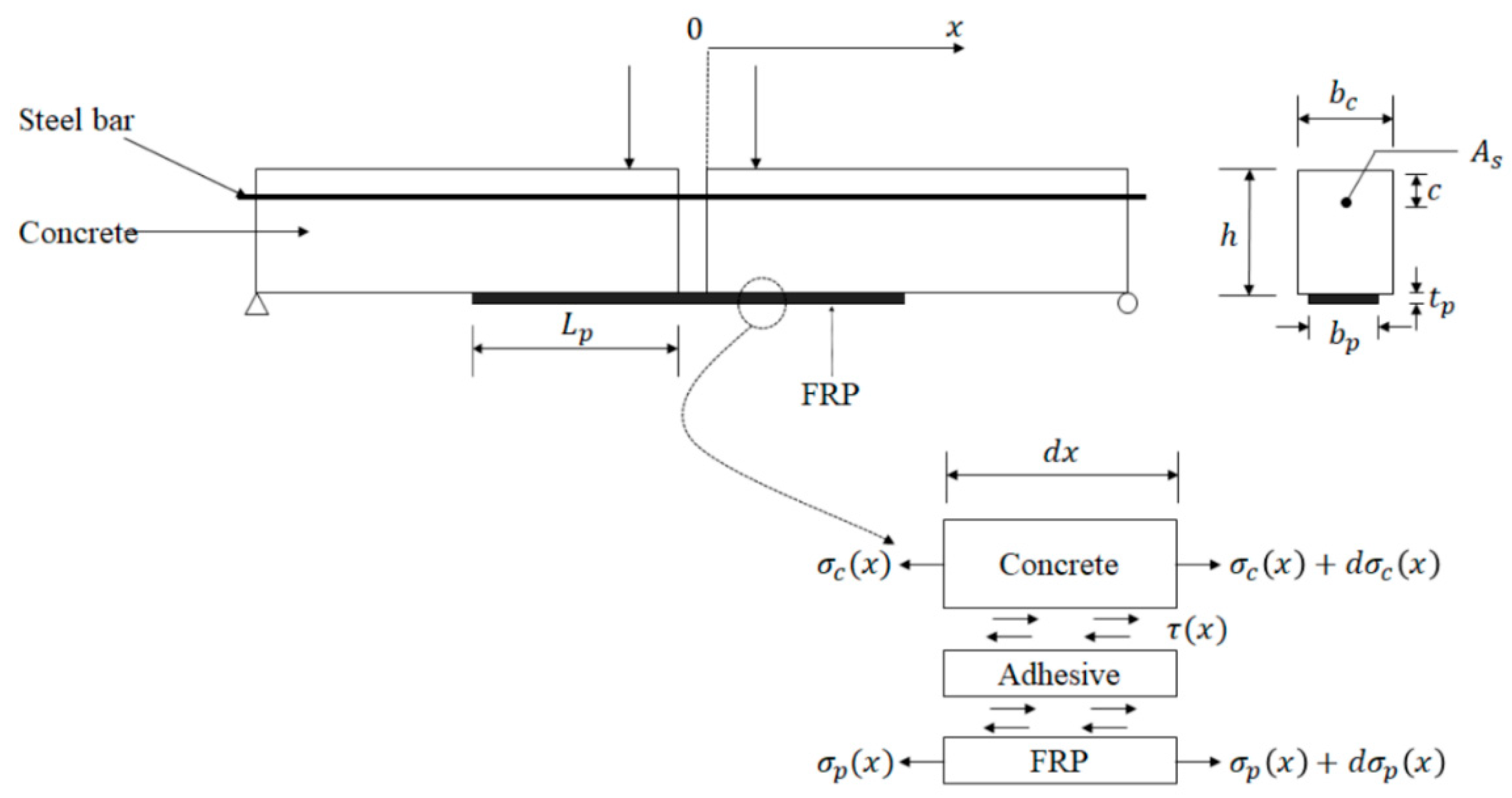



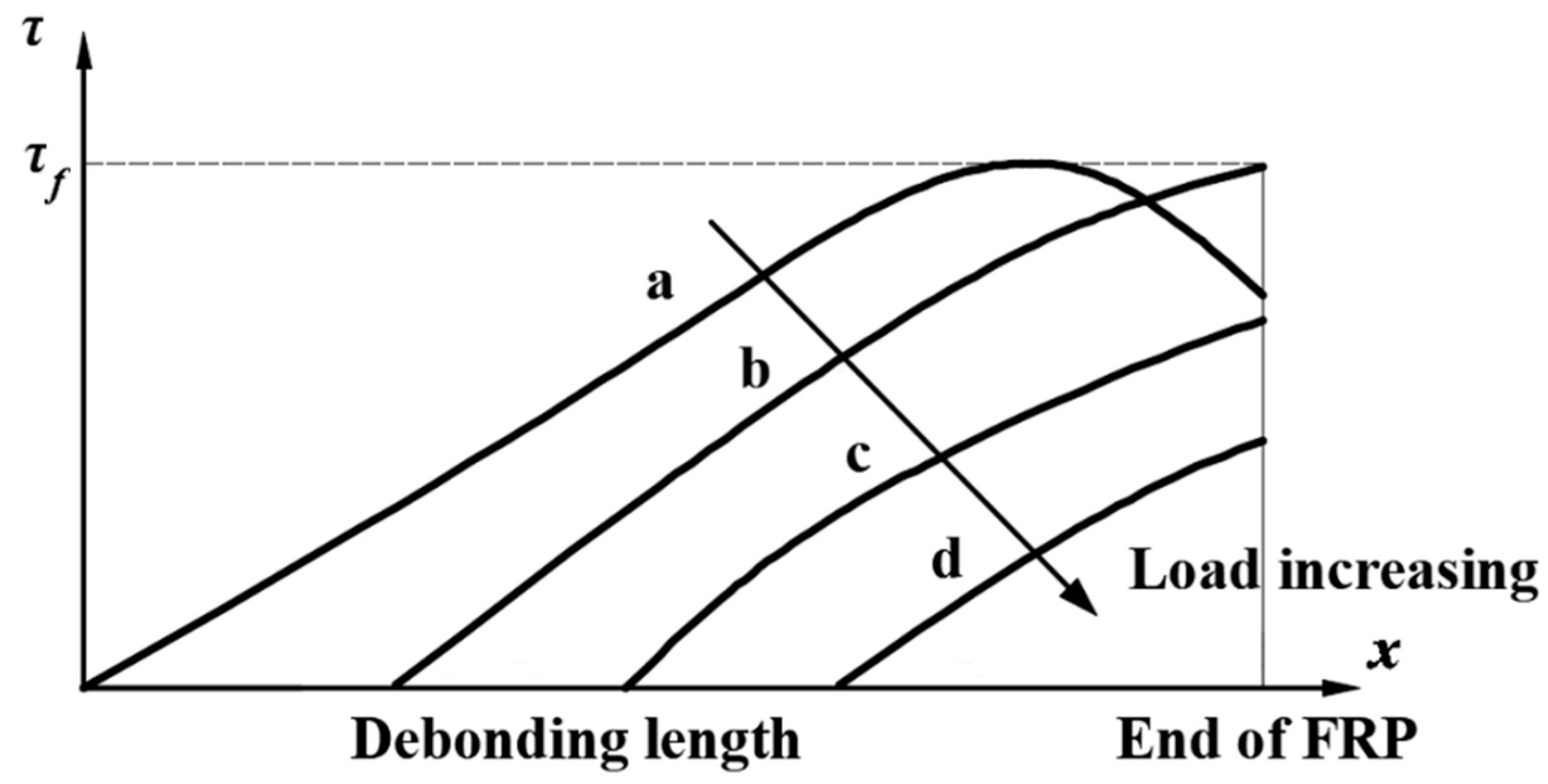
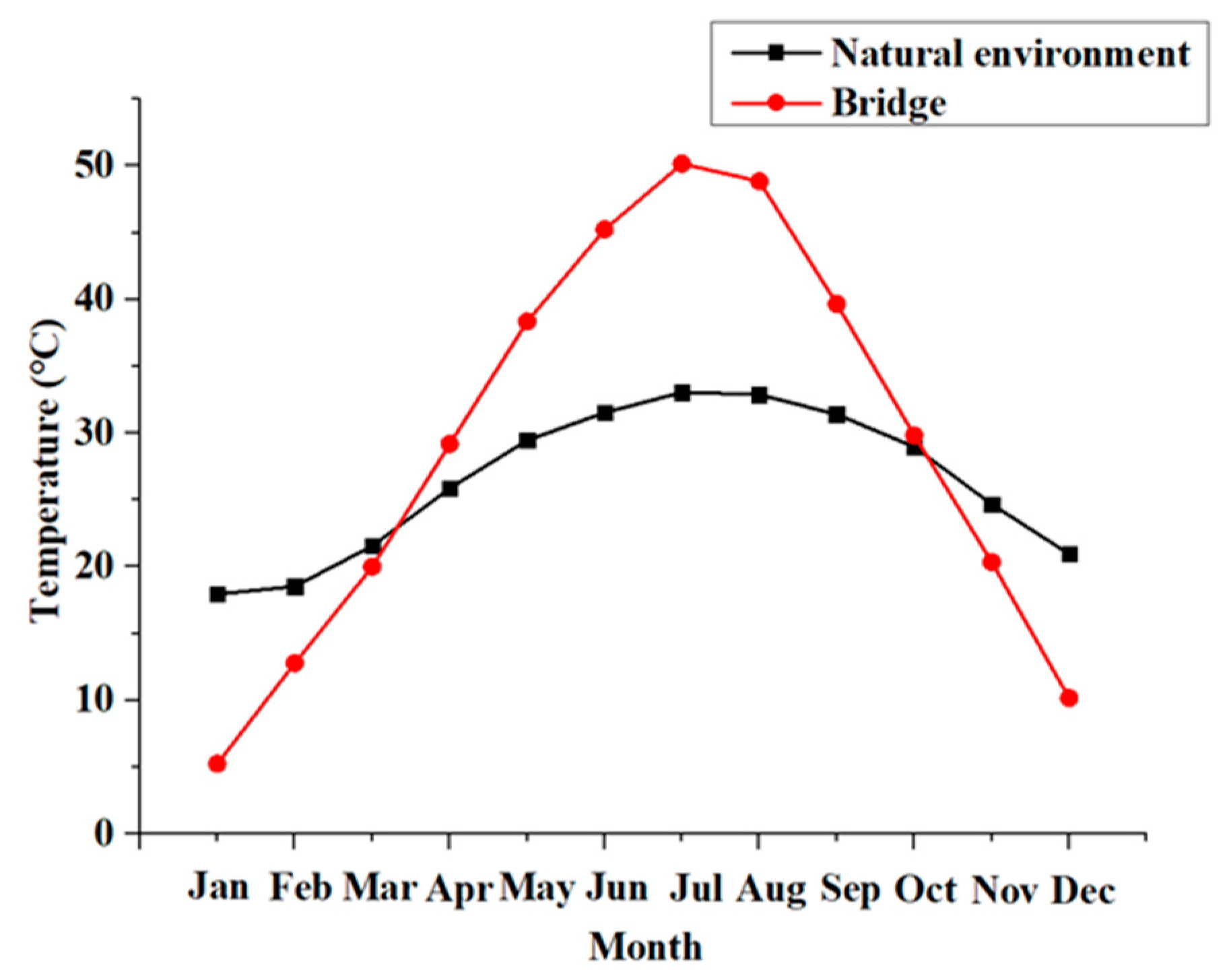


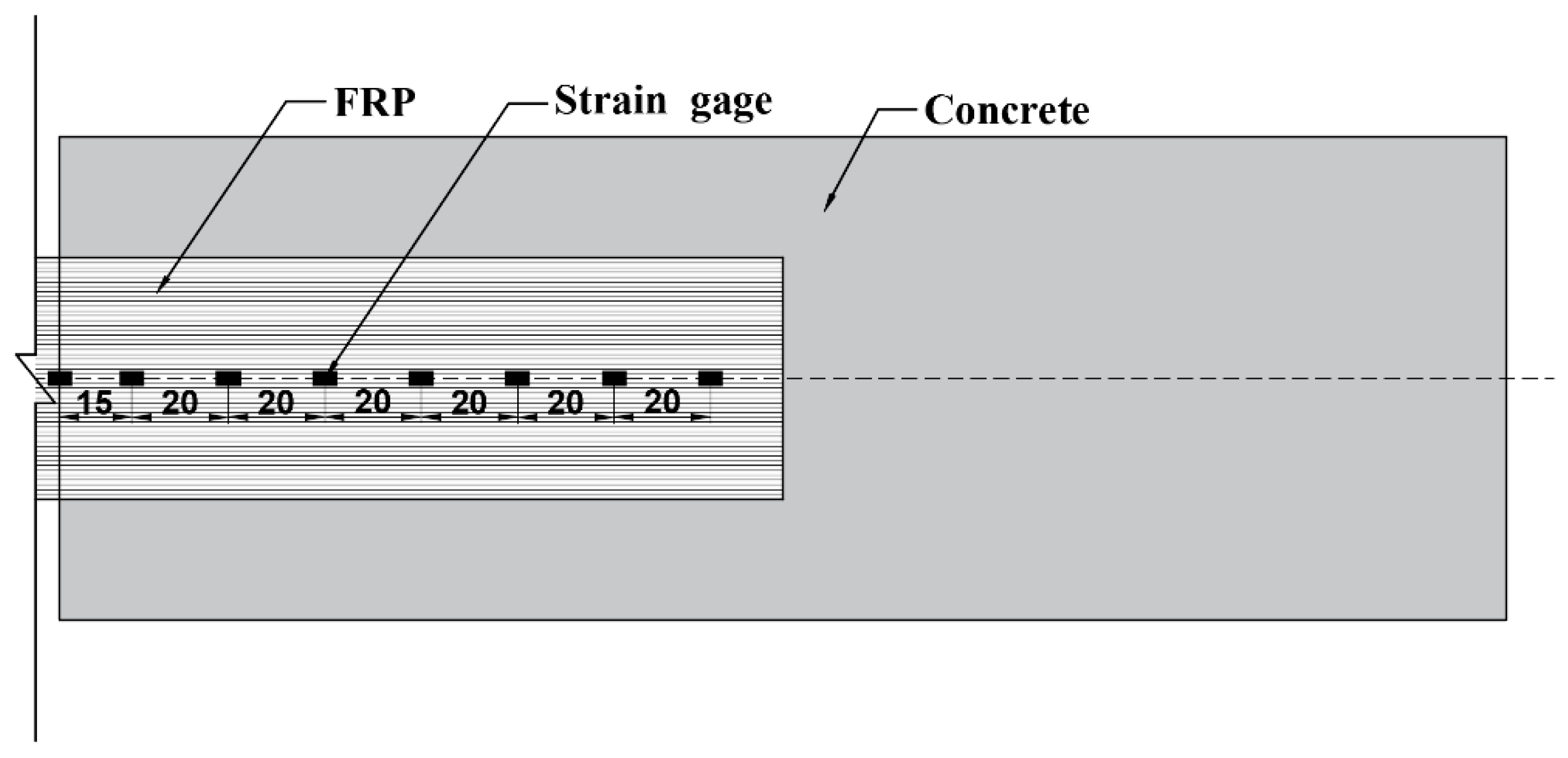



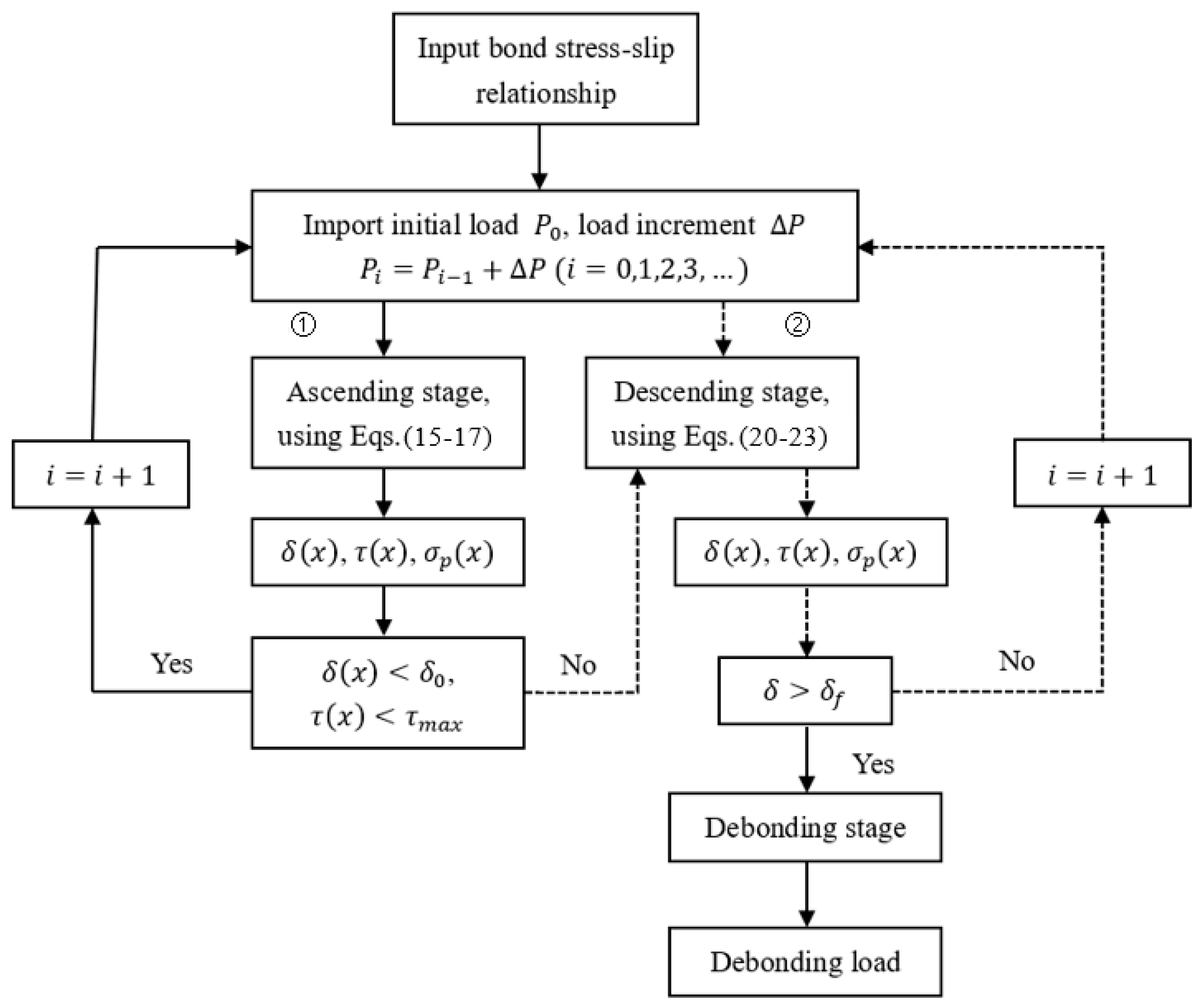

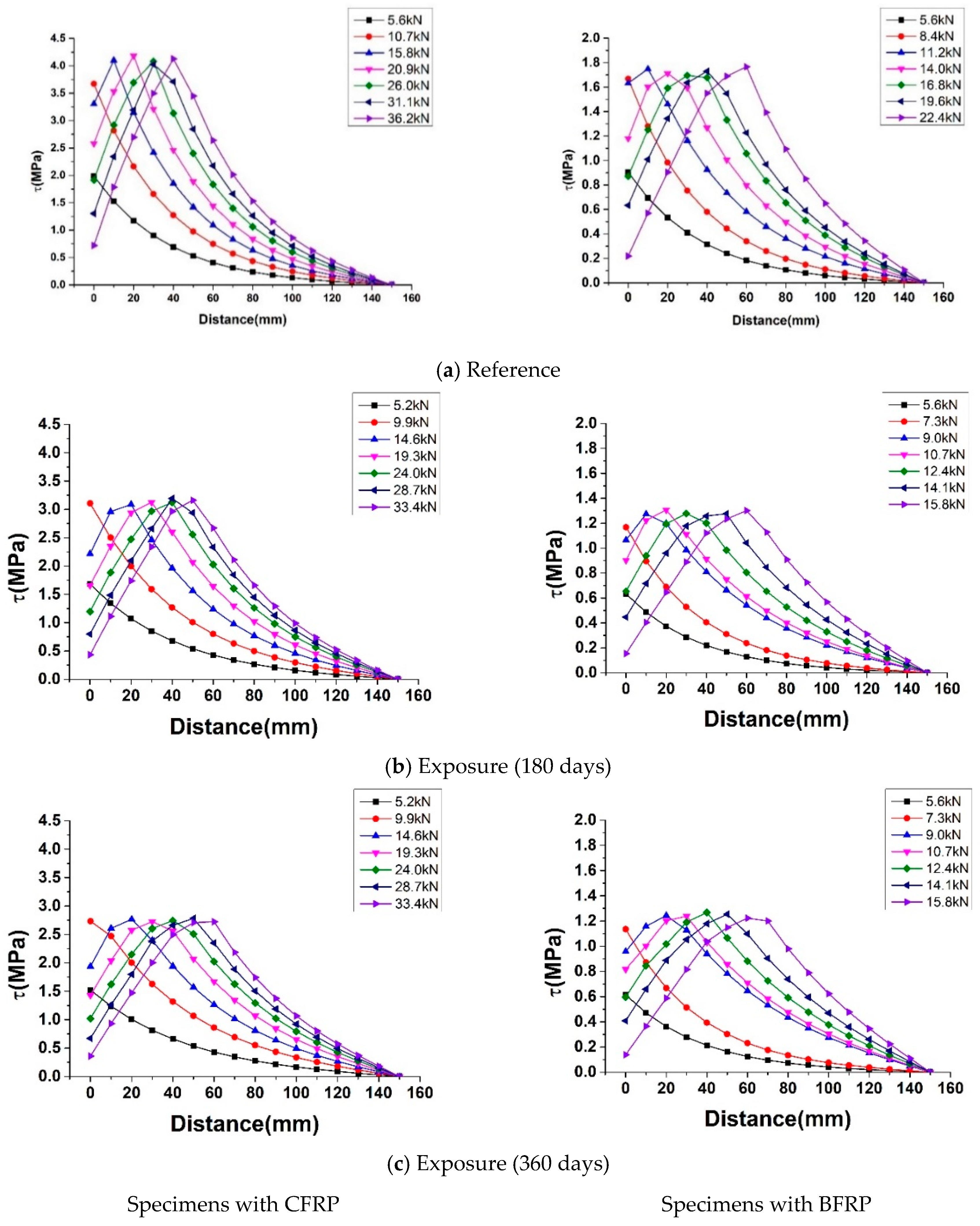

| Materials | Material Characteristics | Values |
|---|---|---|
| Carbon fiber reinforced polymer (CFRP) sheets | Tensile strength (MPa) | 4132 |
| Modulus of elasticity (GPa) | 231 | |
| Elongation (%) | 1.87 | |
| Thickness (mm) | 0.167 | |
| Basalt fiber reinforced polymer (BFRP) sheets | Tensile strength (MPa) | 2100 |
| Modulus of elasticity (GPa) | 91 | |
| Elongation (%) | 2.6 | |
| Thickness (mm) | 0.111 | |
| Epoxy adhesive | Tensile strength (MPa) | 48 |
| Modulus of elasticity (GPa) | 2.378 | |
| Elongation (%) | 1.8 | |
| Concrete | Compressive strength (MPa) | 30.5 |
| Specimens | FRP | Layer | Exposure Period (Days) | Debonding Loads (kN) |
|---|---|---|---|---|
| R-CFRP-0 | CFRP | 1 | 0 | 36.64 |
| NE- CFRP-180 | 1 | 180 | 31.64 | |
| NE- CFRP-360 | 1 | 360 | 32.96 | |
| R-BFRP-0 | BFRP | 1 | 0 | 22.30 |
| NE- BFRP-180 | 1 | 180 | 16.31 | |
| NE- BFRP-360 | 1 | 360 | 16.62 |
| Type | Exposure Time (Days) | (MPa) | (mm) | (mm) | (MPa/mm) | (MPa/mm) |
|---|---|---|---|---|---|---|
| CFRP-concrete | 0 | 4.26 | 0.047 | 0.212 | 90.64 | 25.80 |
| 180 | 3.11 | 0.042 | 0.216 | 74.05 | 17.87 | |
| 360 | 2.80 | 0.045 | 0.239 | 62.22 | 14.43 | |
| BFRP-concrete | 0 | 1.94 | 0.052 | 0.526 | 37.31 | 4.09 |
| 180 | 1.32 | 0.056 | 0.545 | 23.57 | 2.70 | |
| 360 | 1.2 | 0.065 | 0.610 | 18.46 | 2.20 |
© 2020 by the authors. Licensee MDPI, Basel, Switzerland. This article is an open access article distributed under the terms and conditions of the Creative Commons Attribution (CC BY) license (http://creativecommons.org/licenses/by/4.0/).
Share and Cite
Guo, X.; Shu, S.; Wang, Y.; Huang, P.; Lin, J.; Guo, Y. Effect of Subtropical Natural Exposure on the Bond Behavior of FRP-Concrete Interface. Polymers 2020, 12, 967. https://doi.org/10.3390/polym12040967
Guo X, Shu S, Wang Y, Huang P, Lin J, Guo Y. Effect of Subtropical Natural Exposure on the Bond Behavior of FRP-Concrete Interface. Polymers. 2020; 12(4):967. https://doi.org/10.3390/polym12040967
Chicago/Turabian StyleGuo, Xinyan, Shenyunhao Shu, Yilin Wang, Peiyan Huang, Jiaxiang Lin, and Yongchang Guo. 2020. "Effect of Subtropical Natural Exposure on the Bond Behavior of FRP-Concrete Interface" Polymers 12, no. 4: 967. https://doi.org/10.3390/polym12040967
APA StyleGuo, X., Shu, S., Wang, Y., Huang, P., Lin, J., & Guo, Y. (2020). Effect of Subtropical Natural Exposure on the Bond Behavior of FRP-Concrete Interface. Polymers, 12(4), 967. https://doi.org/10.3390/polym12040967






